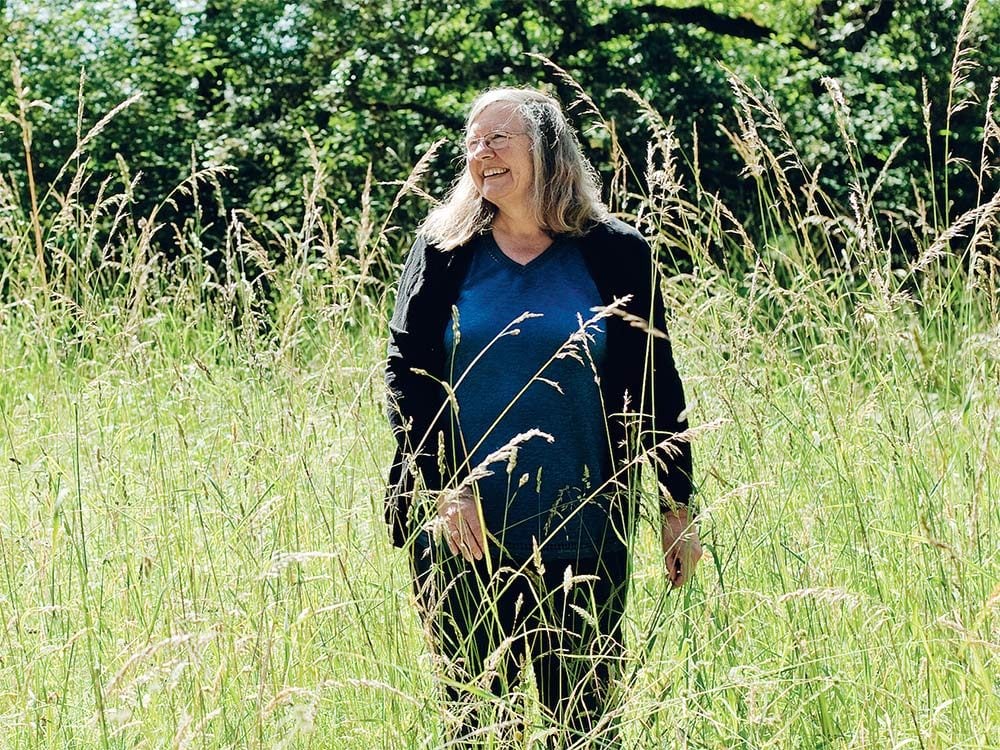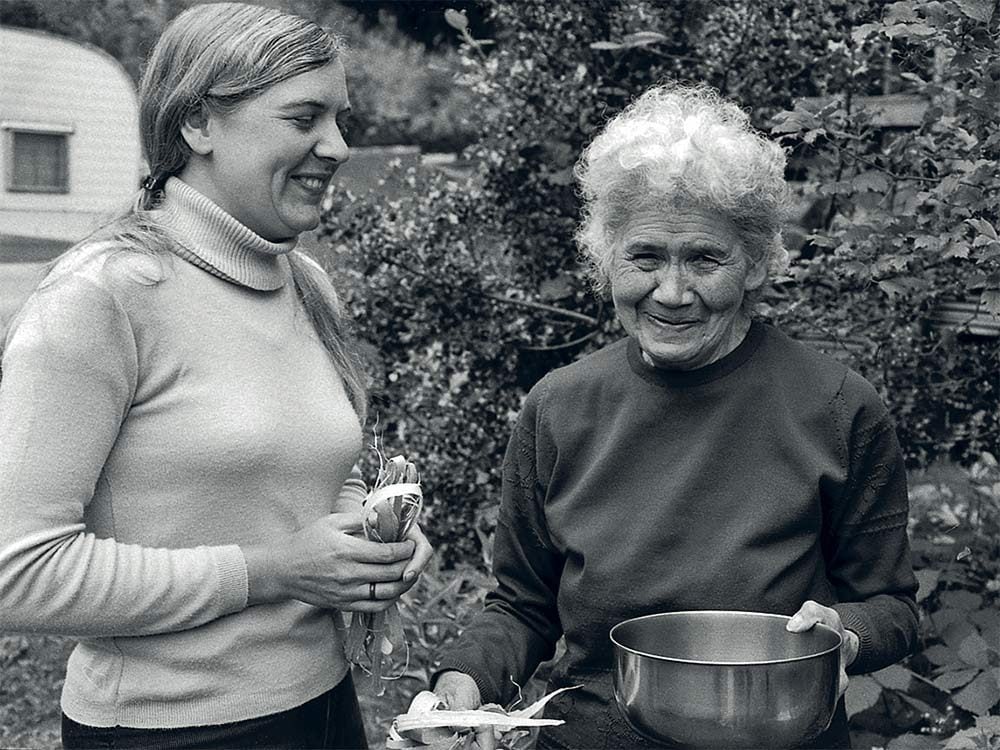
Cultivating wisdom
It is a sunny spring day near the mouth of the Big Qualicum River on British Columbia’s Vancouver Island, and Nancy Turner is hard at work. Brow furrowed, the 69-year-old ethnobotanist arranges hundreds of newly cut plants into two neat lines along a gravel lane. The greenery is death camas. Its teardrop-shaped bulb contains enough poison to kill a child, maybe even a small adult.
For centuries, Indigenous people here carefully cultivated meadows like this one, tending a host of edible plants, from field strawberries and chocolate lilies to one of the staples of Northwest Coast life, a carbohydrate-rich root vegetable called common camas. A century and a half ago, government officials began pressuring the local First Nations to adopt European agriculture. Reluctantly, they complied, grazing cattle and growing hay in their gardens, until weeds invaded the meadows, and knowledge of their valuable plants began to fade.
In May 2016, elders from Qualicum First Nation asked Turner for advice on restoring one of these lost gardens. This afternoon, she and two old friends, Kwaxsistalla (Clan Chief Adam Dick) and Kim Recalma-Clutesi, have been halting the spread of a lethal intruder. After flowering, death camas looks almost identical to the edible variety. The fruiting stalks at our feet contain more than 55,000 death camas seeds—thousands of averted possibilities for further dispersing the poisonous plant.
For more than 40 years, driven by unwavering zeal, Turner has worked closely with coastal First Nations to preserve their traditional knowledge of native plants. An emeritus professor at the University of Victoria in B.C., the ethnobotanist has logged hundreds of thousands of kilometres, sitting down with elders in remote kitchens and recording their ancient learning.
To preserve Indigenous botanical knowledge, Turner has written dozens of books and published nearly 100 scientific articles, many co-authored with elders. She has given public demonstrations of pit cooking, led guided forest walks and field trips, taught a generation of university students and served as an expert witness in land-rights trials. Her curriculum vitae is a hefty 90 pages long.
For Turner, conserving this traditional knowledge has become a deeply personal act of reconciliation. In a country where government officials once placed Indigenous youth in residential schools to “take the Indian out of the child,” she has spent her career trying to reverse that process, passing along essential lore from now-departed elders to their descendants. At a recent celebration of her work in Victoria, many Indigenous leaders stepped forward to publicly thank her. Turner, said Tsawout elder Belinda Claxton, is “a big knowledge keeper for all of us.”
Growing up in Montana, Turner loved exploring the woods and picking wild strawberries. Her entomologist grandfather was an expert on the ants of the Philippines; her father, also an entomologist, studied bark beetles and the role of pheromones in insect communication. By the age of nine, Turner was following in their scientific footsteps. In Victoria, where her family moved in the 1950s after her father took a new job, she joined a natural history club for children. “I was interested in edible plants and how to make dyes,” she says.
In university, she yearned to study ethnobotany, the scientific study of a culture’s relationships with plants. So in the late 1960s, she contacted a local elder, Christopher Paul, who agreed to teach her about the edible and medicinal plants of the Coast Salish people for $2 an hour. The resulting paper was published in 1971 in the prestigious journal Economic Botany. Turner enrolled in a graduate program in ethnobotany and began contacting linguists who were working in First Nation communities to preserve Indigenous languages. Soon she was paying regular visits to elders’ homes. “The people who still speak their language tend to know a lot about the culture,” she says.
From the start, the work was a race against time. On one memorable trip in 1977, an elder showed her how to twist the stems of sandbar willows into a tough, springy rope used to build pit houses or construct suspension bridges across rivers, a skill he had learned as a child. A decade later, heavy machinery had removed all the willows in the stand to widen the road. Today, she says, few people in the region know anything about sandbar-willow rope.
For Turner, the destruction of the willows was an object lesson. When a community loses a culturally important wild habitat, critical information about its plants can disappear, too. Even if the habitat is restored a few decades later, no one who remembers how a plant was once prepared or processed may be left.
On a bright March afternoon, Turner leads the way through a small woodland near her campus office. Shedding light on ancient plant use is difficult, but Turner’s research—based partly on archeological reports and linguistic studies—now links a remarkable shrub known as soapberry to one of humanity’s greatest adventures: the southward migration of Paleoamericans along the Pacific coast near the end of the last ice age, a time known to geologists as the late Pleistocene.
Soapberry, Turner explains, is one of the first plants to follow lichens and mosses in colonizing the moraines left by melting glaciers, and studies show that it took root along the northwest coast soon after the great ice sheets retreated. The shrub, which reaches up to two metres in height, produces clusters of sour-tasting red or orange berries that can be eaten fresh and contain trace levels of natural detergents known as saponins. When squeezed, the berries produce a sudsy foam. If they are added to water and sweetened, they can be whipped like egg whites to make a frothy, rose-coloured confection. Today in some First Nations, families serve this dish at celebrations; many call it “Indian ice cream.”
Linguistic studies suggest that this popular dish has been around for a very long time. The evidence comes from a large family of endangered languages, Salishan, that once extended from southwestern British Columbia to Oregon. Among the 23 languages in this group, at least 19 contain names for soapberry, all of which derive from a root word meaning “to foam or froth.” The oldest name was part of the earliest Salishan language, which was likely spoken in southwestern British Columbia some 5,000 to 7,000 years ago.
Other evidence suggests this “ice cream” dates back even earlier. As Turner points out, Indigenous peoples in the region discovered a unique way of gathering the berries, by spreading a mat below the shrub and beating it with a stick to collect the fallen fruit. They also developed a wide range of related artifacts: picking baskets, birchbark vessels; sturdy whisks; carved or painted wooden spoons; and cylindrical baskets for carrying these spoons to gatherings.
All this dessert culture may have taken millennia to develop. “I suspect that it is indeed an ancient food going back thousands [of years],” Turner says. Along a rugged coast newly freed from its icy prison, brightly coloured soapberries may have welcomed Paleoamericans as they explored a new world.
Learn how this Anishinaabe artist is changing the way we think about the environment.

In the meadow along the Big Qualicum River, Turner gathers up the death camas and says goodbye to Kwaxsistalla, who is sitting on a walker in the meadow. Now 88, the clan chief has been Turner’s teacher and friend for more than two decades. During a conversation in 1996, the elder reminisced about travelling as a young boy from his home in Kingcome Inlet on British Columbia’s central coast, where his family and other high-ranking lineages owned plots of land, to the “root gardens” on the tidal flats. Kwaxsistalla and his relatives gathered edible roots from several species of plants. He told Turner that this process helped the plant “grow better every year,” and described what took place as “fertilizing” and “cultivating.”
“I couldn’t figure out what he was talking about,” Turner says with a grin. Eventually, the elder took her on a trip to Kingcome Inlet. As she watched, he used his digging stick to pry back the moist earth around a mature rice-root plant. In the soil, she saw not only a large bulb but also dozens of small sprouts and bulblets. Each of these could grow into a full plant, he told her. He and his family gathered the bulbs but left behind the bulblets and replanted the sprouts elsewhere. It was a clear example of selective harvesting and sustainable horticulture.
Fascinated, Turner began gathering information about ancient gardens. In the B.C. interior, Secwepemc elder Mary Thomas recalled watching her mother harvesting yellow glacier lily. There were small nodules attached to the edible bulb, known as corms, which the women broke off and replanted. “That brought me to a new way of thinking,” says Turner. Anthropologists had long described B.C.’s Indigenous inhabitants as hunters and gatherers. But these groups were the owners and stewards of gardens. More than 20 years after talking to Thomas, Turner has found traces of many other horticultural techniques employed by ancient Indigenous cultivators in the region.
Yet early European colonists took little notice of all this sophisticated horticulture unfolding around them. They had no idea that the wilderness they saw—the meadows, marshes and forest clearings of the coast—was, in fact, a giant patchwork of gardens.
On the car ride back from the Big Qualicum River, Turner seems quietly elated by the thought that a common camas meadow could be restored along the coast. First Nation leaders, she says, are reviving traditional cultures in the Pacific Northwest, teaching their children to speak ancestral languages, perform ancient dances and prepare traditional foods from native plants.
Like the biological refugia that preserve small relict populations of plants and animals until the return of conditions favourable to spreading, Turner explains, the elders have preserved an encyclopedic knowledge of North American plants, passing it down from one generation to the next. They waited out “times of disturbance,” she says, and now are spreading their knowledge again. And Turner, now edging close to her eighth decade, is also part of this ecology of hope, this ecology of rebirth.
© 2017, Heather Pringle. From “In the Land of Lost Gardens,” Hakai Magazine (June 7, 2017), hakaimagazine.com.
Next, learn about these Canadian heroes, including Cree code talker Charles “Checker” Marvin Tomkins.